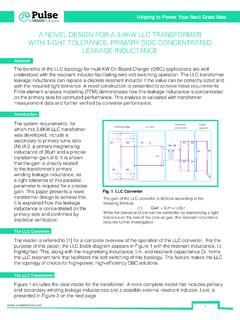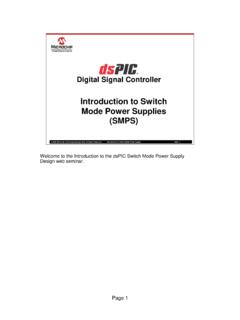Transcription of How does it Work? Common Mode Chokes - Pulse Electronics
1 Helping to power Your Next Great Idea How does it work ? Common Mode Chokes Common Mode Chokes are used in power supply circuits for filtering in a wide range of electronic products. Although ubiquitous, their function and basic operation is often poorly understood. In any modern electronic product, it is highly likely that several different voltages and power conversion circuits will be required for the device to function properly. Creating the functioning circuits is a significant part of the design but ensuring that the circuits do not interfere with one another is equally critical. Radiated and conducted emissions standard (FCC Part 15, CISPR, IEC61000) have been put in place to ensure minimal electrical and magnetic interference.
2 Many best practices exist for designing EMI friendly circuits such as minimizing the length of high current loops, matching input/output impedances, and carefully placing ground references to control current return paths. However, even when these best practices are implemented many systems still require additional filtering. Traditionally, passive filters consisting of inductive and capacitive elements are used to mitigate electronic noise issues and are typically placed close to the noise source, such as near the mains voltage connection for an offline converter. The capacitive element of the filter is usually composed of X and Y rated safety capacitors (typically small capacitance values to limit leakage current and designed to fail as an open circuit, preventing potential harm to the user.)
3 The magnetic portion consists of differential mode inductors and the Common Mode Choke (CMC) or Current Compensation Choke and along with the capacitors form a network of L-C filters. To understand how a CMC works, one must first understand the difference between Common mode noise and differential mode noise. A simplified system is shown below, with two input voltages (for example, 12V and 5V) and one local reference ground. Typically, there will also be a chassis, case, or other system ground' that they system references. It is important to note that parasitic capacitances often exist between PCBs, cabling, and connectors to this system ground'. In a power supply the intended signal originates from the source travels through the supply line to the load and then returns via the established reference ground.
4 Differential Mode noise moves along this same path (red and teal lines below) and appears as the undesired signal in the circuit such as an unwanted oscillation or random signal. Differential mode noise is relatively easy to identify and can be mitigated through the use of a basic L-C circuit using a differential mode choke and capacitor. 1. A more complex and perhaps less intuitive topic is Common mode noise It should be noted that all voltages are relative and in many designs the voltages are relative to a local reference ground. However, parasitic capacitances in a product (perhaps between cables and a chassis in a vehicle, heat sinks and FETs, or product enclosures) can provide a path of low impedance for high frequency current effectively creating an unwanted circuit or loop within the product.
5 In electronic products where high speed signaling such as ethernet, or high frequency switched mode power supplies are present these hard to visualize current paths can become problematic during compliance testing, possibly impacting product performance. Sources and paths for Common mode noise can be difficult to locate and for many engineers the first instinct is to clip an oscilloscope probe to the local ground reference (ie: PCB ground) to get a look' at the noise. However, if the problem is Common mode noise this approach will not detect it as any V_cm will be included in the local ground reference . In other words, V_cmwill be present throughout the circuit, adding to all differential voltages present relative to the system ground.
6 Several examples of components that are part of a CM noise loop could be product enclosures, chassis, cabling, and heat sinks. Although easy to overlook while debugging a circuit, safely measuring voltages relative to these parts may give circuit designers the insight needed to properly solve potential issues. 2. At any given time, both Common mode and differential mode currents may be flowing through a circuit potentially leading to issues with radiated/conducted emissions, or overwhelming sensitive circuitry, such as an op-amp or communication signals. For further reading on how Common mode noise impacts various magnetic components, please refer to our whitepaper Understanding Common Mode Noise.
7 The most Common mitigation strategy, perhaps behind careful board and cable placement, is the use of a filter circuit that presents a high impedance to Common mode currents, limiting the amount the Common mode signal that enters or leaves a PCB. X and Y capacitors are commonly used to shunt the Common mode noise away from the circuits of interest, while a Common mode choke is used to attenuate or dampen the noise. When placing an inductive component such as a choke in the path of current, there are a few key items one must consider. First and foremost, the downstream circuitry should not be negatively impacted by the choke. In general, the winding polarity of a Common mode choke can be set such that the net flux in the core is largely canceled during normal operation and the choke appears invisible' aside from any leakage inductance and winding resistance.
8 In the simplified circuit below, the windings appear in series to the differential currents of the system load, but with opposing polarities. This cancellation can be understood with Faraday's Law and use of the right hand rule . as current flows from the source and into the system through the choke, a voltage on the opposite winding will be developed to oppose the change in flux within the core. However, at the same time, current returning to the source will also pass through the choke and generates its own flux within the core. Assuming that the windings are in phase', the currents are balanced, and the number of turns are equal, these fluxes (and consequently generated voltages) will be equal in magnitude but opposite in direction, resulting in a negligible net increase in flux density.
9 As an added benefit, because the flux contributions to the core from these differential currents cancel out, the CMC is highly unlikely to saturate during normal operation. The same choke will behave much differently when Common mode current flows through it and into the system. In this simplified circuit the windings are now presented in parallel to the current and fluxes no longer cancel out, presenting a large impedance to the Common mode noise signal. As a first pass many designers, when choosing a Common mode choke, will try to maximize this impedance by choosing a part with the highest inductance. This approach is reasonable but does not take into account the change in this impedance with frequency.
10 3. To better understand this impedance requires a deeper look at the circuit model of the Common mode choke. The obvious elements of the model include the inductance and resistance of each winding but to this one must add the leakage inductance between windings (Lleakage), the core loss of each winding (Rloss) and the interwinding capacitance (Cwind). The inductances of the windings and parasitic capacitances/resistances within the component now form a resonant L-C-R. circuit with an impedance that varies with frequency. A simplified circuit model with both windings shorted and leakage inductance treated as a bulk element is shown below. While inductance is a key parameter the other reactive elements of the CMC such as winding capacitance, also play a key role in the filtering response across frequency.




